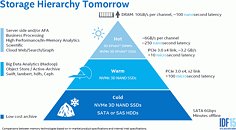Friday, May 19th 2017

Intel to Introduce 3D XPoint DIMM Tech to the Market on 2018
Early on in Intel's 3D XPoint teasers and announcements, the company planned to have this memory integrated not only as a system cache solution or SSD replacement, but also as a potential substitute for DRAM memory. The objective: to revolutionize the amount of DRAM memory a given system can carry, at a much lower price per GB, with a somewhat acceptable performance penalty. Intel describes the current DRAM implementation as too small, too expensive, and too unstable (read: data loss on power loss) to continue being on top of the memory food chain. This is where the 3D Xpoint DIMM implementation can bear fruits, by offering significantly higher amounts of storage at much lower pricing, while keeping attractive bandwidth and latency performance. DRAM will still be used for system-critical operations and booting, albeit in lower capacities, and will be used side by side with these 3D XPoint DIMM slots, which will take in the bulk of the work.
This kind of usage for Intel's 3D XPoint also delivers an interesting side-effect: since this memory is persistent (which means that data isn't lost when the power is turned off,) interruption or loss of power won't erase the work in memory. At the same time, this means that this kind of DRAM-substitute memory requires some security precautions DRAM doesn't, since anyone with direct physical access to the stick could just remove one and take it with all the data inside. Even though a 2018 time to market seems a little to optimistic, considering all the changes this implementation would require from adopters, the technology is definitely promising enough to tempt users to make the jump.
Source:
EXPreview
This kind of usage for Intel's 3D XPoint also delivers an interesting side-effect: since this memory is persistent (which means that data isn't lost when the power is turned off,) interruption or loss of power won't erase the work in memory. At the same time, this means that this kind of DRAM-substitute memory requires some security precautions DRAM doesn't, since anyone with direct physical access to the stick could just remove one and take it with all the data inside. Even though a 2018 time to market seems a little to optimistic, considering all the changes this implementation would require from adopters, the technology is definitely promising enough to tempt users to make the jump.



33 Comments on Intel to Introduce 3D XPoint DIMM Tech to the Market on 2018
Furthermore, RAM needs to be refreshed from time to time (there's an instructions for that) - XPoint doesn't. But once the MC knows what tech is on the DIMM, it'll know what instructions to send.
But other than that, it's accessed the same way RAM is, so it could use the same instructions set (~subset).The system "knows" because it's been designed to know. It also knows the clocks and latencies of RAM. :) That's why Optane is only supported by some CPU+chipset combinations.
But other than that Optane is a lot like RAM and, no offense, all these discussions about it being a cache of some sort are pointless.
It's not like the whole PC idea has to be rebuilt because we're forcing an SSD into a RAM socket. XPoint is a lot more similar to RAM than to a NAND SSD. We should treat it that way.
So now we simply have 2 types of DIMM: fast DDR and slow (but larger and persistent) XPoint. It's only important for the PC to know how to use them.
If we had such choice from the start, XPoint would seem totally natural.
So the OS has to know what should be put in XPoint. Intel shows it with the best-case scenario: in-memory analytical databases. XPoint has the advantage of size, but also is fast enough for that (i.e. it won't ruin the performance compared to DDR).
I guess it'll be also great for rendering and large numerical projects, when RAM size and cost can be limiting.
However, in the consumer world XPoint could work not as a "slower RAM" but as a faster and smaller persistent storage. We'll see how this tech matures (and how the price evolves), but it seems we might soon get PCs with all memory put in DIMMs. :)
The problem is that it requires more pins on the processor. More pins means more costs.